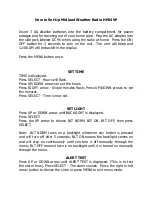
105
Parameter
Type of
Calibration
Default Typical Calibration Source
Temperatur
e
Offset
Current
Value
Red Spirit or Mercury Thermometer (1)
Humidity
Offset
Current
Value
Sling Psychrometer (2)
ABS
Barometer
Offset
Current
Value
Calibrated laboratory grade barometer
REL
Barometer
Offset
Current
Value
Local airport (3)
Wind
Direction
Offset
Current
Value
GPS, Compass (4)
Solar
Radiation
Gain
1.00
Calibrated laboratory grade solar radiation
sensor
1 w/m
2
Gain
126.7
lux
Solar radiation conversion from lux to w/m
2
for wavelength correction (5)
Wind
Gain
1.00
Calibrated laboratory grade wind meter (6)
Rain
Gain
1.00
Sight glass rain gauge with an aperture of
at least 4” (7)
Daily Rain
Offset
Current
Value
Apply an offset if the weather station was
not operating for the entire day.
Weekly
Rain
Offset
Current
Value
Apply an offset if the weather station was
not operating for the entire week.
Monthly
Rain
Offset
Current
Value
Apply an offset if the weather station was
not operating for the entire month.
Yearly Rain
Offset
Current
Value
Apply an offset if the weather station was
not operating for the entire year.
(1) Temperature errors can occur when a sensor is placed too close to a heat source
(such
as
a
building
structure,
the
ground
or
trees).
To calibrate temperature, we recommend a mercury or red spirit (fluid) thermometer.
Bi-metal (dial) and digital thermometers (from other weather stations) are not a good
source and have their own margin of error. Using a local weather station in your area is
also a poor source due to changes in location, timing (airport weather stations are only
updated once per hour) and possible calibration errors (many official weather stations
are
not
properly
installed
and
calibrated).
Place the sensor in a shaded, controlled environment next to the fluid thermometer,
and allow the sensor to stabilize for 3 hours. Compare this temperature to the fluid
thermometer and adjust the console to match the fluid thermometer.















































